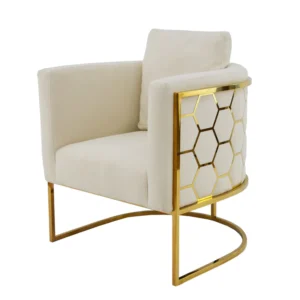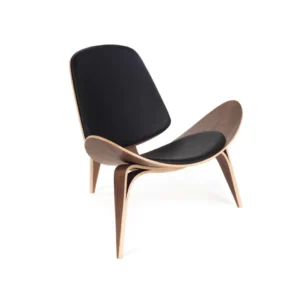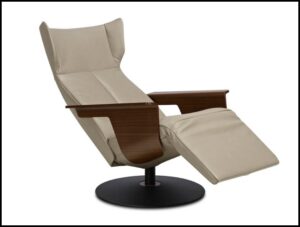Chairs play a pivotal role in interior design, transcending mere functionality to become a statement piece that reflects style, comfort, and individuality. As we delve into the world of chairs, let’s explore their fascinating history, the diverse styles available, the range of materials they can be crafted from, and essential tips for making the right choices when adding chairs to your interior spaces.
A Brief History:
The history of chairs is as rich and diverse as the cultures that have embraced them. Dating back to ancient civilizations, chairs were initially reserved for nobility and high-ranking officials. The Greeks and Romans elevated the design, introducing intricate carvings and cushioned seats. During the Middle Ages, chairs became more widely used but were still reserved for the elite. It wasn’t until the Renaissance that chairs began to be more accessible, evolving in style and design over the centuries to suit changing tastes and needs.
The different Styles of chairs available:
There are countless styles of chairs, each with its own unique design elements and characteristics. Here are some common styles:

Traditional/Classic: These chairs often feature ornate woodwork, plush upholstery, and elegant details. They can be inspired by various historical periods such as Victorian, Georgian, or Louis XVI styles.

Modern/Contemporary: Clean lines, minimalistic designs, and often using materials like metal, plastic, or glass characterize modern chairs. They focus on functionality and simplicity.

Mid-Century Modern: This style emerged in the mid-20th century and is known for its sleek, organic shapes, often with tapered legs and bold colours. Famous designers like Charles and Ray Eames and Eero Saarinen contributed iconic pieces to this style.

Scandinavian/Nordic: Influenced by Scandinavian design principles, these chairs are typically characterized by simplicity, functionality, and natural materials such as wood and leather. They often feature clean lines and gentle curves.

Industrial: Inspired by the utilitarian design of factories and warehouses, industrial chairs often incorporate raw materials like steel, iron, and reclaimed wood. They may have a rugged, unfinished look with exposed hardware.

Retro/Vintage: These chairs evoke styles from past decades, such as the 1950s or 1960s. They can feature bold colours, geometric patterns, and unique shapes, capturing the spirit of a particular era.

Transitional: Combining elements of both traditional and contemporary styles, transitional chairs strike a balance between classic elegance and modern simplicity. They often feature clean lines with subtle decorative touches.

Rustic: Rustic chairs are characterized by their rugged, natural appearance. They often feature distressed wood, rough-hewn finishes, and simple, sturdy construction, evoking a sense of warmth and cosiness.

French Provincial: Inspired by the French countryside, these chairs often feature curved lines, ornate carvings, and a distressed finish. They evoke a sense of vintage charm and elegance.

Parsons: Parsons chairs are characterized by their simple, clean lines and upholstered seats and backs. They have a versatile design that can fit seamlessly into various interior styles, from modern to traditional.

Egg Chair: Designed by Arne Jacobsen in 1958, the Egg Chair features a distinctive rounded shape that envelops the sitter. It’s often upholstered in leather or fabric and is a symbol of mid-century modern design.

Chesterfield: Chesterfield chairs are known for their luxurious button-tufted upholstery, rolled arms, and distinctive silhouette. They exude classic elegance and are often associated with upscale interiors.

Wingback: Wingback chairs feature “wings” on either side of the backrest, originally designed to shield the sitter from drafts. They often have high backs and are upholstered for comfort, adding a touch of sophistication to any space.

Ghost Chair: Designed by Philippe Starck, the Ghost Chair is made of transparent polycarbonate, creating a modern and whimsical appearance. It’s a minimalist yet eye-catching addition to contemporary interiors.
The Different Types of Chairs available:
Chairs come in various types, each designed for specific purposes or environments. Here are some common types of chairs:

Dining Chair: Designed for use at a dining table, these chairs typically have straight backs and are often upholstered for comfort during meals.

Armchair: Armchairs feature armrests on either side and are designed for relaxation and comfort. They come in various styles and sizes, from traditional to modern.

Lounge Chair: Lounge chairs are intended for relaxation, often featuring a reclined backrest and a comfortable seat. They can be found in living rooms, bedrooms, or outdoor spaces.

Accent Chair: Accent chairs are meant to add visual interest and style to a room. They often feature bold colours, patterns, or unique designs and can serve as focal points in a space.

Club Chair: Club chairs are typically upholstered and have a low back and deep seat, providing a cosy and inviting seating option. They originated in gentlemen’s clubs and are now popular in homes and offices.

Rocking Chair: Rocking chairs have curved legs that allow them to rock back and forth. They are often used for relaxation or soothing activities like reading or nursing.

Recliner Chair: Recliner chairs have a backrest that can be adjusted backward and a footrest that can be extended, allowing the sitter to recline and relax in a comfortable position.

Office Chair: Designed for use at a desk or workstation, office chairs are typically adjustable in height and may have features like armrests, lumbar support, and swivel bases for enhanced comfort and ergonomics.

Bar Stool: Bar stools are tall chairs designed for seating at a bar or high countertop. They often have a simple design with a footrest for added comfort.

Bean Bag Chair: Bean bag chairs are made of fabric filled with small, soft pellets or beans. They mould to the shape of the sitter’s body, providing a casual and comfortable seating option.

Chaise Lounge: Chaise lounges feature an elongated seat for reclining or stretching out. They are often used for relaxation indoors or outdoors.
Materials Chairs Can Be Made From:
Wood: Wood remains a timeless and versatile material for chairs. From the warmth of oak and walnut to the elegance of mahogany, wooden chairs can suit a variety of design styles.
Metal: Metals like steel, aluminium, and wrought iron are used to create modern and industrial-style chairs. These materials provide durability and a sleek, contemporary aesthetic.
Upholstery: Upholstered chairs, whether traditional or modern, often feature fabric, leather, or a combination of both. The choice of upholstery can significantly impact the chair’s comfort and visual appeal.
Plastic: Plastic chairs are lightweight, affordable, and available in various colours. Modern designs often utilize moulded plastic to create eye-catching and ergonomic chairs.
Do’s and Don’ts When Buying Chairs:
Do:
Consider Comfort: Prioritize comfort when selecting chairs, especially for spaces where you’ll spend extended periods.
Measure Your Space: Ensure the chairs fit comfortably within the allocated space without overcrowding or creating a cramped environment.
Mix and Match Styles: Experiment with different chair styles to add visual interest and personality to your interior design.
Check Quality: Invest in well-constructed chairs made from high-quality materials to ensure longevity and durability.
Don’t:
Overlook Maintenance: Consider the maintenance requirements of the chairs, especially if you have pets or children. Easily cleanable materials may be preferable.
Ignore Ergonomics: Pay attention to the ergonomic features of chairs, especially for office or dining settings where comfort is paramount.
Disregard Aesthetics: While functionality is crucial, don’t compromise on aesthetics. Choose chairs that enhance the overall design of the space.
Forget About Flexibility: Opt for chairs that can adapt to different occasions. Folding or stackable chairs can be invaluable for accommodating varying guest numbers.
Chairs are not just pieces of furniture; they are integral components of interior design that shape the ambiance and character of a space. Understanding the history, styles, materials, and essential considerations when buying chairs will empower you to make informed choices, ensuring that your seating arrangements are both visually appealing and functionally comfortable. Whether you prefer the timeless elegance of traditional designs or the sleek modernity of contemporary styles, the world of chairs offers a vast array of options to suit every taste and design preference.




